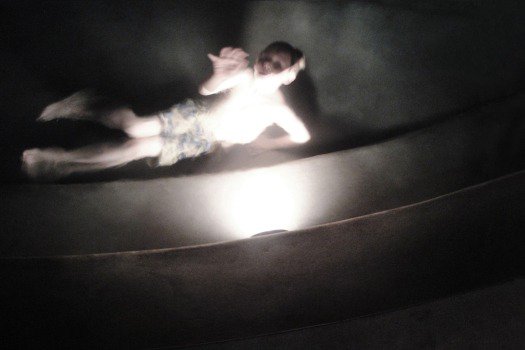Two Exhibitions
dal 23/8/2013 al 16/11/2013
Segnalato da
23/8/2013
Two Exhibitions
Museum Folkwang, Essen
"Everything Is Nothing without Its Reflection" is on show alongside Douglas Gordon's video installation Silence, Exile, Deceit - An Industrial Pantomime. The Ruhrtriennale realisation of Nowhere and Everywhere, by William Forsythe, at the Same Time No. 2 marks an entirely new chapter in the development of this choreographic work.

Douglas Gordon
Everything Is Nothing without Its Reflection
A Photographic Pantomime
24. 8. – 17. 11. 2013
Countless large and small frames arranged closely side by side camouflage the walls of the exhibition room: travel shots, playing children, a butcher’s display window and the beholder’s own reflection in the in-between mirror. The artist Douglas Gordon will premiere a new installation with photographs at Museum Folkwang.
Everything Is Nothing without Its Reflection will be on show alongside Douglas Gordon’s video installation Silence, Exile, Deceit – An Industrial Pantomime which he formulated on the occasion of the Ruhrtriennale in the mixing plant of the coking plant at Zollverein UNESCO World Heritage Site (23 August – 6 December 2013).
Douglas Gordon is one of the most influential artists of his generation. Born in Glasgow in 1966, he lives in Berlin and Glasgow today. Having won the Turner and Kollwitz Prizes, he shot to fame with movies such as 24 Hour Psycho and Zidane: A 21st Century Portrait, which he made together with Philippe Parreno. In addition to extensive video installations and photographs, his artistic output includes conceptual textual pieces, sculptural installations and performances. His investigation of the images of our collective memory and everyday culture is intended to expose the fundamental patterns of perception. Polar opposites such as life/death, good/bad, guilty/innocent and temptation/fear dominate his work.
----
William Forsythe
Nowhere and Everywhere
23. 8. - 8. 9. 2013
The American choreographer William Forsythe is the first artist to utilizethe entire space available in the Große Hallein the new building for the Museum Folkwang designed by David Chipperfield.
The Ruhrtriennale realisation of Nowhere and Everywhere at the Same Time No. 2 marks an entirely new chapter in the developmentof this choreographic work. Originally created for a solo dancer and 40 pendulums in anabandoned building on New Yorks historicHigh Line, the installation has been continuously developed in contexts as diverse as the monumental industrial architecture of the Turbine Hall of the Tate Modern, and the historical setting provided by the Arsenale of the Venice Biennale. This new edition preserves and privileges two central interests in Forsythe's oeuvre: counterpoint and the unconscious choreographic competence induced by choreographic situations. Suspended from automated grids, more than 400 pendulums are activated to initiate a sweeping 15 part counterpoint of tempi, spacial juxtaposition and gradients of centrifugal force which offers the spectator a constantly morphing labyrinth of significant complexity. The spectators are free to attempt a navigation this statistically unpredictable environment, but are requested to avoid coming in contact with any of the swinging pendulums. This task,which automatically initiates and alerts the spectators innate predictive faculties, produces a lively choreography of manifold and intricateavoidance strategies.
In the interactive video work City of Abstracts, the visitors are drawn into a mael-strom of twirling shapes, unexpectedly becoming participants in the action. William Forsythe has shaped contemporary dance in a unique way. His works have kept the practice of ballet from being solely identified with the classical realm, transforming it into a dynamic art form of the twenty-first century. But his artistic practice also includes performance, film, installations, choreographic objects and internet-based education.
Forsythe will also present a selection from his Lectures from Improvisation Technologies – a collection of 60 film studies which contains the most important principles of his language of movement and his art of improvisation, including the film Solo, a rare opportunity to see Forsythe as a dancer.
Offerings at the Department of Education and Communication
Guides
August 24 until September 8, Tues – Sun, 11 a.m. – 6 p.m. and Fri 11 a.m. – 9 p.m.
William Forsythe’s choreographies are interactive. He uses different media and locations in Museum Folkwang and includes visitors in his installations. During the exhibition period, employees of the Department of Education and Communication will be available to discuss impressions and aspects of the show with visitors.
Introduction to the exhibition
Tues–Sun, 11 a.m. & 1/3/5 p.m., Fri, 11 a.m. & 1/3/5/7 p.m.
Employees of the Department of Education and Communication explain the exhibition concept in introductory sessions (30 minutes).
Free with admission ticket. Meeting point: Visitor information desk.
Press contact:
Doerthe Ramin T +49 201 8845 103/160 F +49 201 8891 45 000
doerthe.ramin@museum-folkwang.essen.de
Anna Littmann T +49 201 8845 160 F +49 201 8891 45000
anna.littmann@museum-folkwang.essen.de - presse@museum-folkwang.essen.de
Opening Friday Agust 23, 2013, 11 a.m.
Museum Folkwang
Museumsplatz 1 45128 Essen
Hours:
Tue to Sun 10 a.m. to 6 p.m.
Fri 10 a.m. to 10.30 p.m.
Mon closed
Admission
Standard: 5.00 €
Reduced: 3.50 €
Entrance free for children under 6 years



